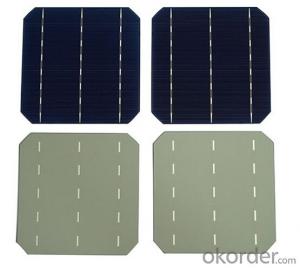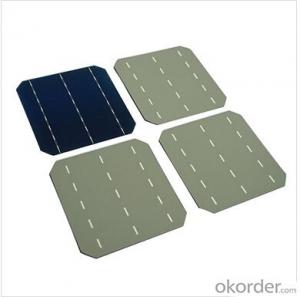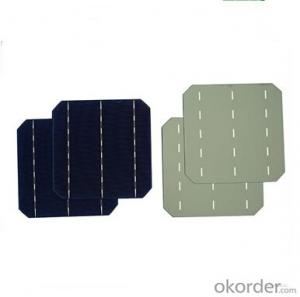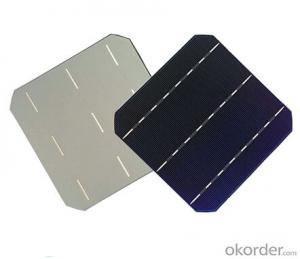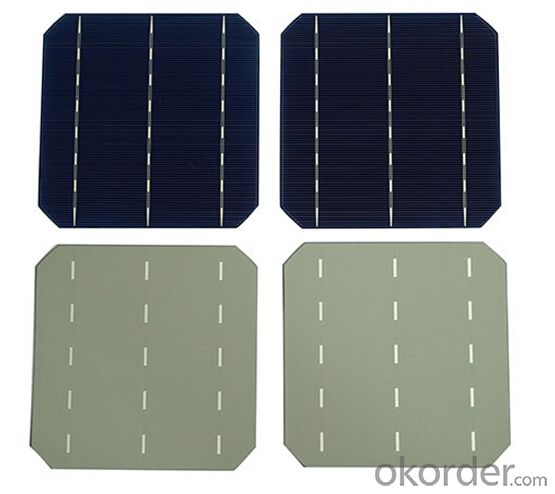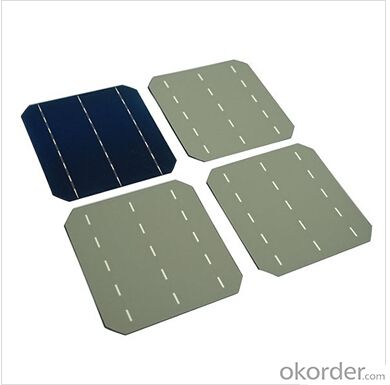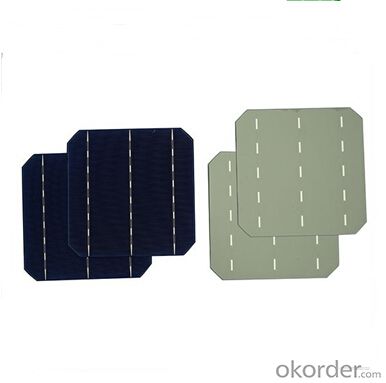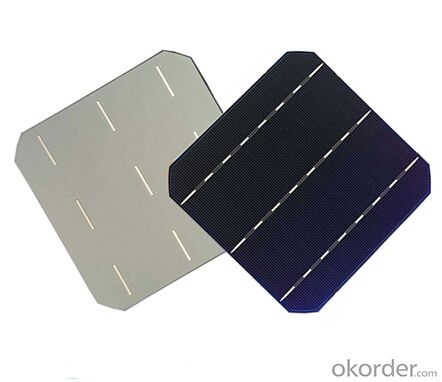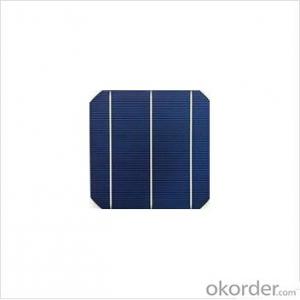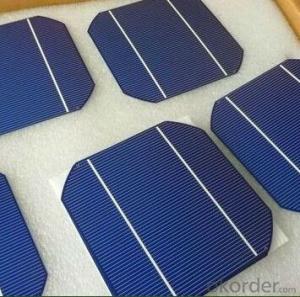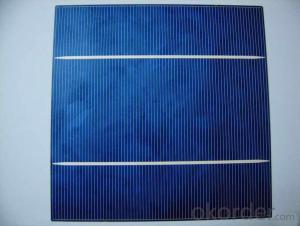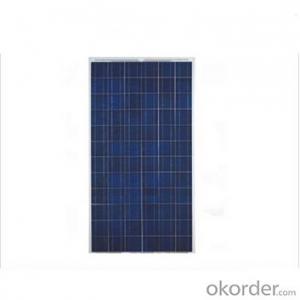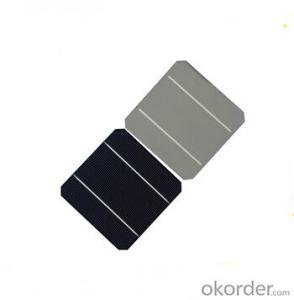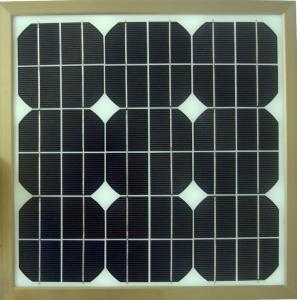Hexagonal A Grade Monocrystalline Solar Cells 17.4x17.6
- Loading Port:
- Shanghai
- Payment Terms:
- TT or LC
- Min Order Qty:
- 5000 pc
- Supply Capability:
- 80000 pc/month
OKorder Service Pledge
OKorder Financial Service
You Might Also Like
Monocrystalline Solar Cells A GRADE
Solar cells is made by solar wafer, it has three categories of solar cell right now, monocrystalline polycrystalline and thin film,These cells are entirely based around the concept of ap-n junction, which is the critical part of solar module, it is the part that can convert the light energy into electricity, the thickness is from 180um to 200um, with even busbars to conduct electricity, textured cell can decrease diffuse reflection; they are often electrically connected and encapsulated as a module. Photovoltaic modules often have a sheet of glass on the front (sun up) side, allowing light to pass while protecting semiconductor wafers from abrasion and impact due to wind-driven debris, rain, hail, etc. Solar cells are also usually connected in series in modules, creating an additive voltage. Connecting cells in parallel will yield a higher current;With high quality and stable quality. Our Cells can greatly improve the performance of Solar Modules.
Advantage of Monocrystalline Solar Cells
• High efficiency and stable performance in photovoltaic conversion.
• Advanced diffusion technique ensuring the homogeneity of energy conversion efficiency of the cell.
• Advanced PECVD film forming, providing a dark blue silicon nitride anti-reflection film of homogenous color and attractive appearance.
• High quality metal paste for back surface and electrode, ensuring good conductivity, high pulling strength and ease of soldering.
• High precision patterning using screen printing, ensuring accurate busbar location for ease with automatic soldering a laser cutting.
Specifications of Monocrystalline Solar Cells
Format : 156 mm × 156 mm ± 0.5 mm
Thickness: 210 μm ±40 μm
Front (-) : 1.5mm bus bars (silver),blue anti-reflection coating (silicon nitride)
Back (+) : 2.5mm wide soldering pads (silver) back surface field (aluminium)
Efficiency (%) Pmpp (W) Umpp (V) Impp (A) Uoc (V) Isc (A) |
18.20% 4.43 0.536 8.263 0.634 8.712 |
18.00% 4.38 0.535 - 8.188 0.633 8.701 |
17.80% - 4.33 0.534 - -8.112 ---0.632 ----8.652 |
17.60% 4.28 0.533 8.036 0.631 8.641 |
17.40% 4.23 0.529 8.005 0.630 8.591 |
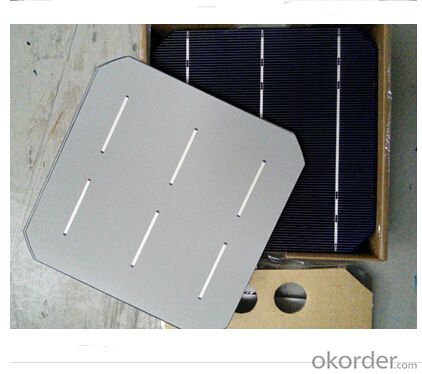
FAQ
We have organized several common questions for our clients,may help you sincerely:
①What price for each watt?
It depends on the efficiency of the solar cell, quantity, delivery date and payment terms.
②How long can we receive the product after purchase?
In the purchase of product within three working days, We will arrange the factory delivery as soon as possible. The pecific time of receiving is related to the state and position of customers.Commonly 7 to 10 working days can be served.
③Can you provide the peripheral products of the solar panels, such as the battery, controller, and inverter? If so, can you tell me how do they match each other?
Yes, we can, we have two companies for solar region, one is CNBM International, the other is CNBM engineering Co.
We can provide you not only the solar module but also the off grid solar system, we can also provide you service with on grid plant.
④What is your warranty of solar cell?
Our product can promise lower than 0.3% open box crack, we support claim after opening the box if it has crackm color difference or sth, the buyer should give pictures immediately, we can not accept the claim after the solar cell has assembled to solar panel.
• Timeliness of delivery
• ⑤How do you pack your products?
We have rich experience on how to pack the solar cell to make sure the safety on shipment, we could use wooden box or pallet as buyer's preference.
New Way of Making Solar Cells Promises Cheaper Power
A new way of making solar cells promises a cheaper way to generate electricity from the sun and new ways to integrate solar power into other products. When the light comes in and is both directly absorbed by the wires, and some of the light bounces around in between the wires. In fact, the absorption enhancement that we see is in the range of 20 to 50 times the single-pass absorbance. The principles with the wire arrays is grow them on a supporting substrate, and peel them off inside a plastic sheet, so that the material has exactly the optical and electrical properties of a silicon wafer, but instead it basically has the mechanical properties of a flexible plastic sheet. Except that, the flexibility opens the door to potential new applications. For example, the solar cell could be built into roofing material, saving money on installation. Other ideas for new uses come from the physical form of Atwater's novel design.
The more wonderful thing about solar energy is that it's accessible and available everywhere in the world, from the cloudiest place in northern Europe to the sunniest place in north-central Africa to the Outback of Australia to South Asia. And in fact the use of solar energy is growing worldwide for that reason."
To make the solar cells greener and more efficient, The scientists used the bacteria Mycobacterium smegmatis. In fact,A mycobacterium is a type of pathogen that can cause diseases such as tuberculosis, but the species scientists utilized in the study is harmless and can be found in soil and cornflakes. It also produces the protein MspA, which can be used for numerous applications once it has been chemically purified.
After purifying the protein, Scientist combines it with a synthesized dye that is less toxic than traditional dyes. The protein-dye mixture is coated onto individual solar cells and tested with artificial sunlight to measure energy output.
The core idea is that the protein acts as a matrix for electron transfer for this dye that absorbs sunlight. We want the protein to be able to capture the electron that the dye gives out and then transfer that electron in one direction, thereby generating an electrical current.
The new dye-sensitized solar cells do not currently improve on the technology’s ability to convert sunlight into electrical current, but they are the first of their kind and could help low-cost solar cells become a more viable option for alternative energy applications.
This type of research where you have a biodegradable or environmentally friendly component inside a solar cell has not been done before, and the research is still in its early stages right now. But we have noticed that it’s working, and that means that the protein is not decomposed in the light and electric generating conditions. Because of that, we believe that we’ve actually made the first protein-incorporated solar cell.
- Q: How do solar cells perform in areas with high humidity?
- Solar cells typically perform slightly less efficiently in areas with high humidity due to the presence of moisture in the air. The water vapor can reduce the amount of sunlight reaching the solar cells and can also cause corrosion over time. However, modern solar cell designs have improved significantly to mitigate these effects and ensure reliable performance even in humid conditions.
- Q: Can solar cells be used at night?
- No, solar cells cannot be used at night as they rely on sunlight to generate electricity.
- Q: Can solar cells be used to power farms or agricultural operations?
- Yes, solar cells can be used to power farms or agricultural operations. Solar panels can be installed on rooftops, fields, or other suitable areas to convert sunlight into electricity. This renewable energy source can provide a consistent and sustainable power supply for various farming activities, such as irrigation systems, machinery, and storage facilities. Additionally, solar power helps reduce reliance on fossil fuels, lowers operational costs, and contributes to a greener and more environmentally friendly agricultural sector.
- Q: Can solar cells be used in agricultural settings?
- Yes, solar cells can be used in agricultural settings. They can be used to power various agricultural equipment such as irrigation systems, electric fences, and lighting. Solar cells can also be used to generate electricity for on-site use or for feeding back into the grid, reducing energy costs and promoting sustainability in agricultural practices. Additionally, solar cells can be integrated into greenhouse structures to provide power for ventilation, heating, and cooling systems, creating a more energy-efficient and environmentally friendly agricultural environment.
- Q: What is the impact of solar cells on reducing electricity bills?
- Solar cells have a significant impact on reducing electricity bills as they harness the power of the sun to generate clean and renewable energy. By producing electricity on-site, solar cells can offset a considerable portion of a household's or business's energy consumption, leading to substantial savings on monthly electricity bills. Moreover, excess energy generated by solar cells can be fed back into the grid, allowing homeowners and businesses to earn credits or even receive payments for the surplus energy they contribute. Overall, solar cells offer a sustainable and cost-effective solution to reduce electricity bills and promote energy independence.
- Q: Can solar cells be used to power remote oil and gas monitoring systems?
- Yes, solar cells can be used to power remote oil and gas monitoring systems. Solar cells are a reliable and sustainable source of renewable energy that can be used to generate electricity in remote locations where access to the grid is limited. By harnessing the power of the sun, solar cells can provide a continuous supply of electricity to power monitoring systems for oil and gas operations, ensuring efficient and reliable monitoring in remote areas. Additionally, solar power offers environmental benefits by reducing reliance on fossil fuels and minimizing carbon emissions.
- Q: What is the role of solar cells in powering off-grid cabins?
- The role of solar cells in powering off-grid cabins is to convert sunlight into electricity, providing a clean and sustainable source of power. Solar cells, also known as photovoltaic cells, capture photons from the sun and generate direct current (DC) electricity. This electricity can then be stored in batteries for use during periods of low sunlight or used directly to power various appliances and systems in the cabin. Solar cells allow off-grid cabins to operate independently from the traditional power grid, reducing reliance on fossil fuels and minimizing environmental impact.
- Q: Can the solar powered cells really work better than the normal cells?
- There is no doubt that the solar powered cells work better than the normal cells, the only disadvantage is the cost of making it.
- Q: Solar water heater plate can be directly converted into electrical energy?
- batteries: generally lead-acid batteries, small micro-system, can also be used nickel-metal hydride batteries, nickel-cadmium batteries or lithium batteries. The role is to light when the solar panels issued by the energy stored to the need Time to release again.
- Q: Are solar cells affected by temperature changes?
- Yes, solar cells are affected by temperature changes. As the temperature increases, the efficiency of solar cells decreases. This is because higher temperatures can cause an increase in the electron-hole recombination rate, leading to a reduction in the generation of electricity. Conversely, lower temperatures can improve the performance of solar cells by reducing thermal losses. However, extreme temperature changes can also cause stress and potential damage to the cells, so maintaining a moderate operating temperature is important for optimal performance.
Send your message to us
Hexagonal A Grade Monocrystalline Solar Cells 17.4x17.6
- Loading Port:
- Shanghai
- Payment Terms:
- TT or LC
- Min Order Qty:
- 5000 pc
- Supply Capability:
- 80000 pc/month
OKorder Service Pledge
OKorder Financial Service
Similar products
Hot products
Hot Searches
Related keywords
